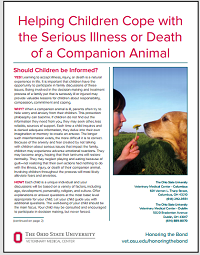Helping Children with the Euthanasia of a Pet
Helping children cope
• Don’t hide your pet’s condition from children
• Include them in caregiving
• Discuss all treatment and end of life options together
• Avoid decisions made in haste
Preparing kids for euthanasia
• Emphasize that euthanasia is a loving act of courage
• Explain that natural death can be painful and cause suffering
• Help them understand the “need” for euthanasia when there are no other options
• Educate them about the process – before, during, and after
• Avoid the phrase “put to sleep” or “put down”
• Younger children require a clearer explanation in order to understand the finality
• Explain that the pet will die peacefully without feeling hurt or scared
Should children be present or not?
• Recommended age is 10 and older; we recommend at least 13 years of age.
• Whether they are present or not, allow them to view the body afterwards
• Final goodbye can help kids to accept the reality
How can I support my child through his or her grief?
someone to be present with them while they are experiencing the pain of grief as
they mourn
• Provide an environment that allows your child to feel and talk about the grief
• Communication should be open, honest, and ongoing
• Experience it together
• Assure them they are not responsible for the pet’s death
• The realization that death is permanent does not happen until around the age of 8
• Encourage the expression of feelings verbally and/or through art
• Know that children have a natural ability to “dose” themselves with grief and are
able to take a break from it when needed. (They can do this much better than adults.)
How to discuss aftercare
• Cremation can be described as “returning to ashes”
• Make it clear the pet is not hurt in the process
• With respect to burial, describe how the pet will be placed in a box and laid to rest
in the ground where he will be safe
Honoring a pet’s life
• Make a tribute table
• Design a gravestone
• Assemble a scrapbook or collage
• Write a poem or story
• Plant a tree
• Make a donation in the pet’s name
• Volunteer at the animal shelter or Humane Society
• Just share stories and memories!
When/if to adopt again
• Adopting too quickly may delay mourning
• Children may take longer to move through grief

